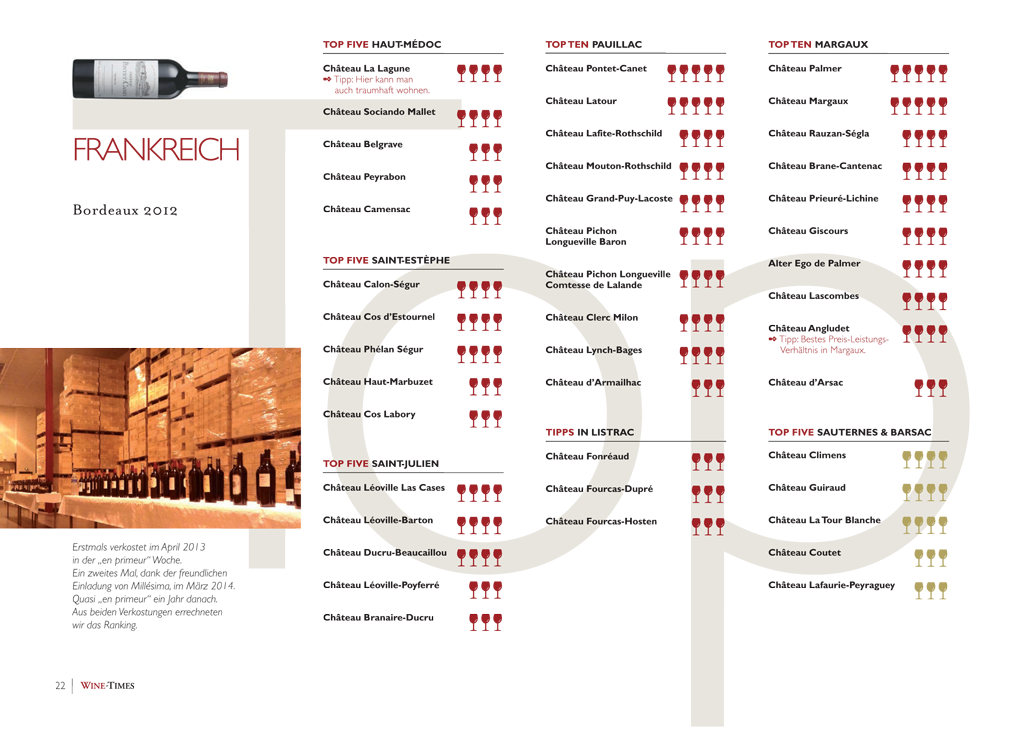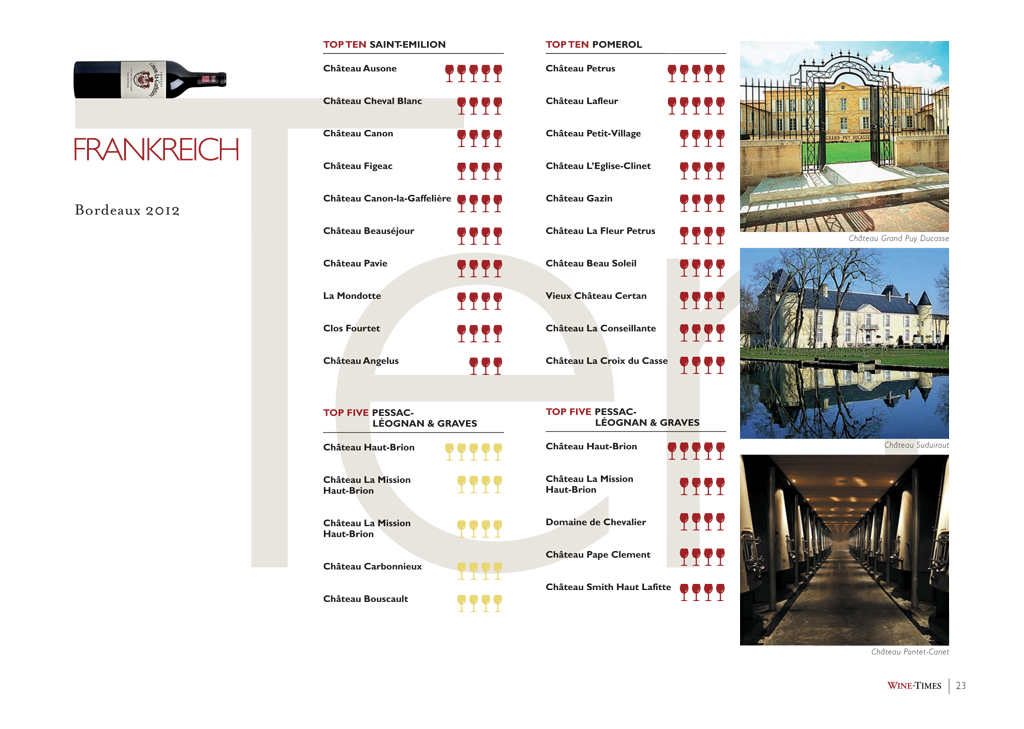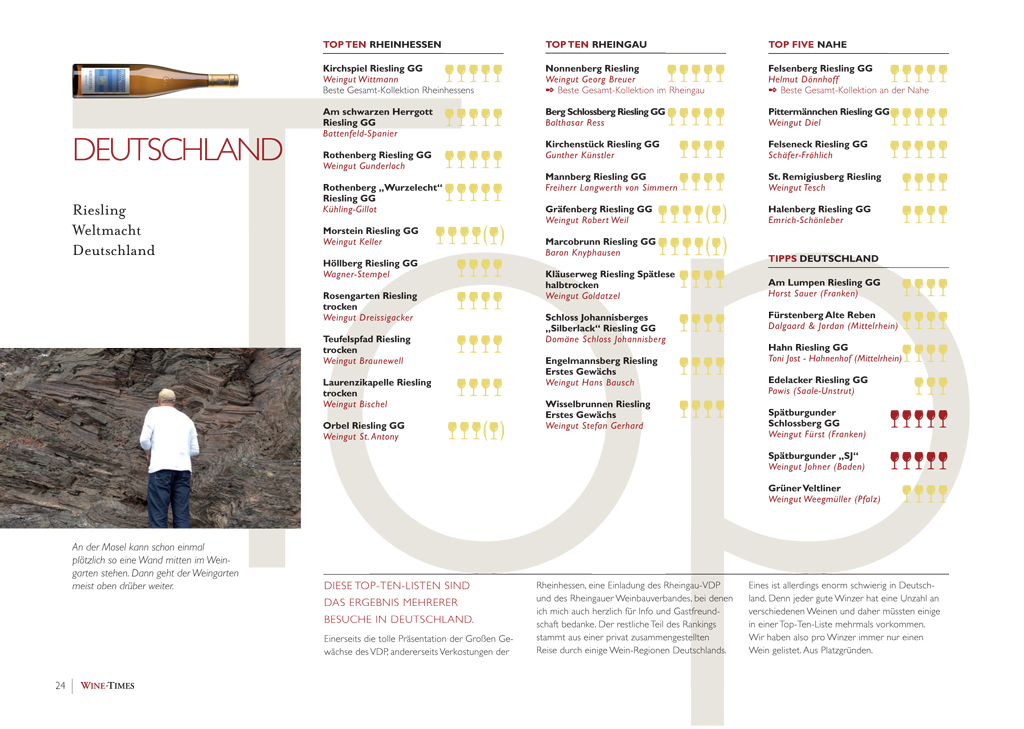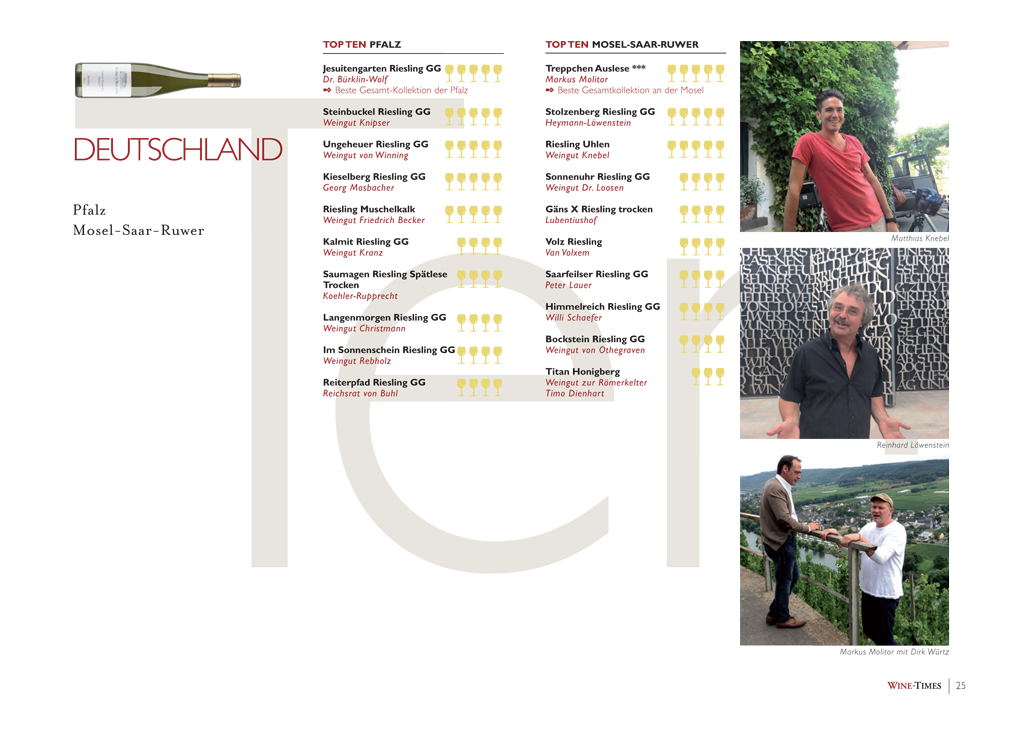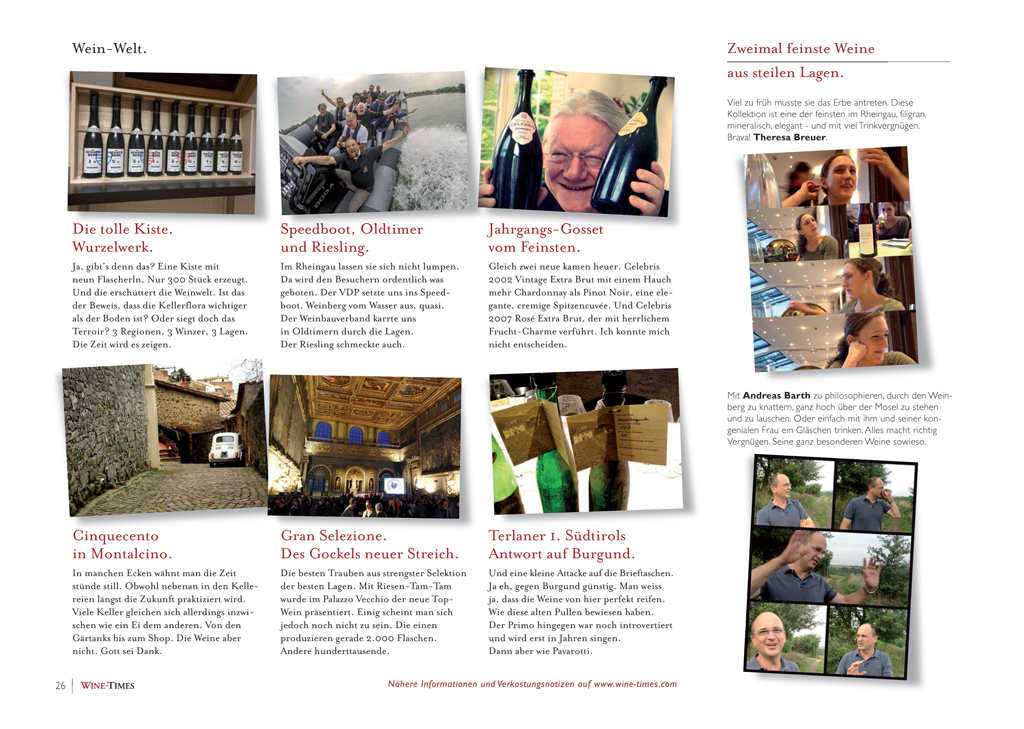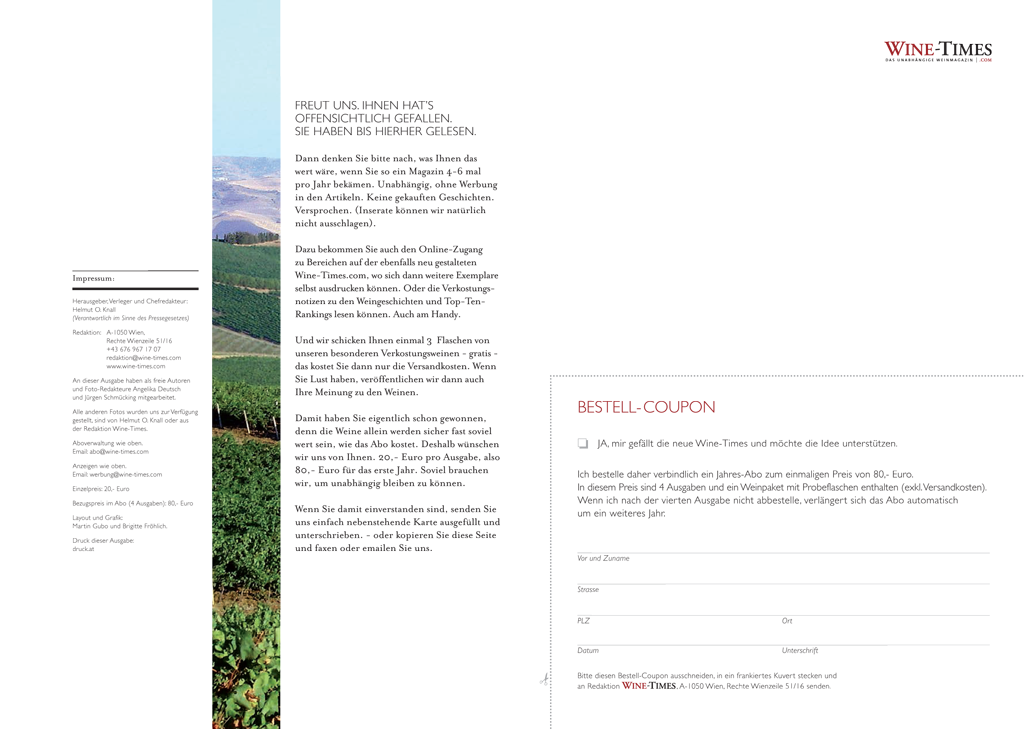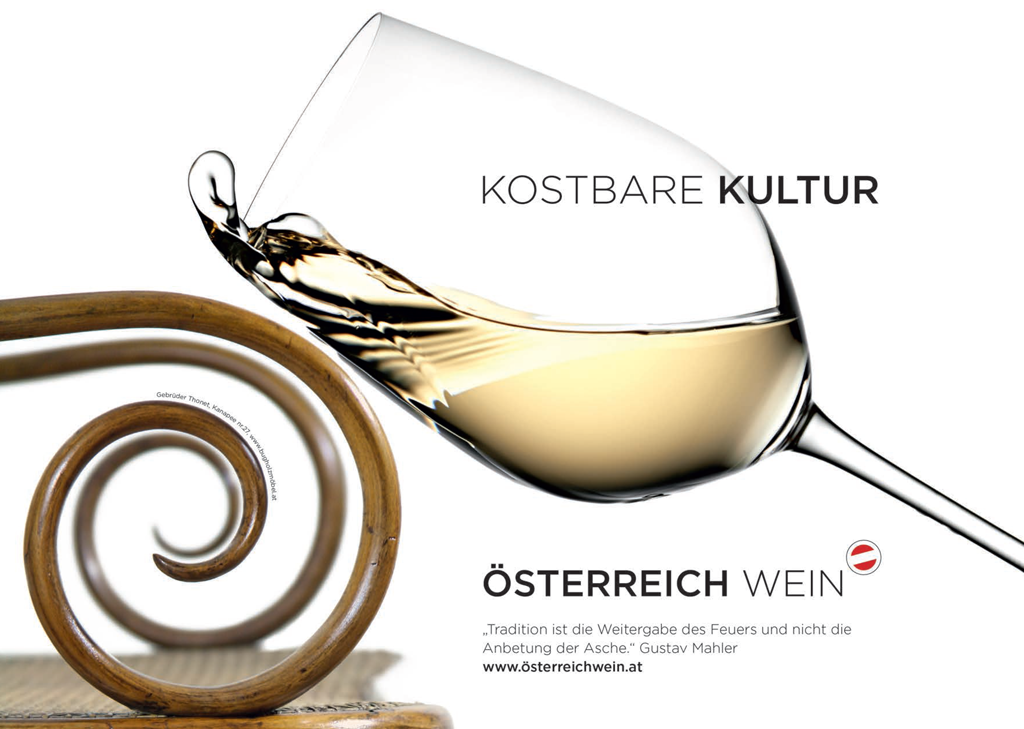Hier geht's zum aktuellen Wine-Guide-Austria in deutscher Sprache, dem ultimativen Nachschlagewerk zum österreichischen Wein.
The Tuscan Marathon.
A report from John U. Salvi, Master of Wine.
Almost 1000 wines to taste in less than one week. Such was the monumental task that faced some 200 wine journalists and writers from all over the world, invited to what have for several years been known as the "Tuscan Anteprima".

More than 400 Chianti Classico to taste in only two days...
There is a polemic with the term Anteprima as, literally translated, this means “before the first”. One would normally expect this to be the latest vintage – in this case the 2008. This is the case with the famous Bordeaux En Primeur tastings at the end of March/begin April following the vintage.
However there were very few 2008s available for tasting, except for the white Vernaccia, and in many ways this is perfectly understandable. February is, in all honesty, too early to taste the wines of the latest vintage as they are not yet stabilised and in many cases have not yet fallen bright. Certainly they have not yet been fined or filtered. They are what we term “brut”. Considerable wine knowledge is required to taste such wines and be able to evaluate them and assess their future.
Regretfully not all of our journalistic fraternity have a profound knowledge of wine – far from it unfortunately. Many write about anything from sport, to fashion, to politics with wine simply an accessory and perhaps even an excuse for an enjoyable, bibulous and gastronomic trip abroad. Growers therefore have reasonable justification for being anxious about showing such unfinished wines to unpolished tasters. It is very hard to explain them to those without the knowledge and the wines risk being misjudged and badly noted. I have said that this is understandable, but it is however a considerable problem for some of us who write for Wine Revues and editors whose main interest lies in a report and an evaluation of the new vintage. It is hard to see how this problem can be resolved unless the tastings are held much later in the year when the wines are perfectly ready to taste.
However there were very few 2008s available for tasting, except for the white Vernaccia, and in many ways this is perfectly understandable. February is, in all honesty, too early to taste the wines of the latest vintage as they are not yet stabilised and in many cases have not yet fallen bright. Certainly they have not yet been fined or filtered. They are what we term “brut”. Considerable wine knowledge is required to taste such wines and be able to evaluate them and assess their future.
Regretfully not all of our journalistic fraternity have a profound knowledge of wine – far from it unfortunately. Many write about anything from sport, to fashion, to politics with wine simply an accessory and perhaps even an excuse for an enjoyable, bibulous and gastronomic trip abroad. Growers therefore have reasonable justification for being anxious about showing such unfinished wines to unpolished tasters. It is very hard to explain them to those without the knowledge and the wines risk being misjudged and badly noted. I have said that this is understandable, but it is however a considerable problem for some of us who write for Wine Revues and editors whose main interest lies in a report and an evaluation of the new vintage. It is hard to see how this problem can be resolved unless the tastings are held much later in the year when the wines are perfectly ready to taste.
Chianti Classico Collection.

The room with all the producers.
I mentioned above that these tastings have inexactly been known as the Anteprima. Chianti Classico has recently seen the light and changed this to “The Chianti Classico Collection”. It takes place in the immense Stazione Leopolda, in Florence, and boasts 148 producers presenting 358 different Chianti Classico labels and 70 barrel samples.
In Chianti Classico today there are 597 producers (345 of them bottlers) with 18,000 hectares of DOCG registered vineyards producing around 37 Million bottles. 73% is exported and annual sales amount to some 270 Million Euros. Over the last 10 years more than 10,000 hectares of vines have been replanted at an average cost of 60,000 Euros/hectare. Over 100 Million Euros have been spent modernising both cellars and equipment.
How does a wine writer/journalist approach such a tasting with less than 2 full days at his disposal? Of course it is impossible to taste all or even half that number, at least in any depth. Does one taste those that are renowned - the great and the famous? Does one taste the names that are known to one? Or does one look for new wines which one does not know, and if so how does one choose which wines to taste?
Many journalists are totally confused by such numbers and do not know which way to turn. Each journalist (or support) has to decide his own approach and mine personally is to track down all the 2008s available and then look at other wines if I have time. Here there were 70 of them, but this throws up yet another problem, at least for me.
There are 2 ways of tasting. First one is to sit comfortably at a table with a numbered list of all the wines. One writes the numbers of the wines that one wishes to taste on a piece of paper and hands it to a hovering sommelier. He will then bring the chosen wines to you, four at a time, and in excellent tasting glasses. This can be slow and tedious when many journalists are tasting at the same time and because the catalogue (which one is given on arrival) is not in the same order as the numbered list at the tables. Much more seriously, as far as I was concerned, none of the 2008s were on the numbered list or available to be tasted at the tables.
The second way of tasting (of course one can do both), where the 2008s were available, is only in force on the second of the two days. To my mind this second system is much more instructive, informative, useful, valuable, rewarding and enjoyable. Here, in another vast room, the producers each stand behind a table, marked with their name and number, on which stand all their wines. One walks round and round, stops at whichever table one wishes and tastes as many wines as one wishes or has time for. One can either just ask for a taste, note it down and move on, or one can engage a real conversation about the wines, the vines, the vinification, wine making techniques, the viticulture, the producer’s philosophy, the weather during the growing season and its meteorological problems, and even the growers love life if you both feel so inclined! This way one collects vast, indeed almost indigestible, quantities of information, particularly if one is technically inclined as I am or writes for more technical publications. I pat myself on the back for having succeeded in tasting almost all 70 of the 2008s as well as many others.
I found that, on the whole, the quality of the fruit was rather purer and more elegant than in the 2007s. The aromas were also more perfumed and generous. The 2008 Chianti Classico wines are beginning to show that elegance and finesse. They have a sound structure, roundness and completeness and promise to age well and make excellent bottles.
How do they become like this? 2008 had a dry January and February. Then a very wet spring led into an early summer with precocious growth. Rain however persisted into the flowering period and the vine suffered both “shatter” and “chicken and egg”. Bunches were therefore loose and open, good for aeration. From late June there was a long hot summer right through to the vintage. None the less oidium and perenospera persisted and work in the vineyards was intense with more spraying than usual and strict and conscientious deleafing. There was some good rain mid July. Vintage conditions were fine and dry and growers brought in healthy and very ripe grapes. Some people had had hail in both July and September with moderate losses. Polyphenols were on the whole ripe, sugar content was high, alcoholic content was also therefore high. Acidities were good, but all this called for rigorous selection. Sangiovese, the vast majority of the grapes, enjoyed unusually good and deep colour.
These few lines on the weather and vintage conditions apply generally both to the Vin Nobile di Montepulciano and the Brunello di Montalcino that follow.
In Chianti Classico today there are 597 producers (345 of them bottlers) with 18,000 hectares of DOCG registered vineyards producing around 37 Million bottles. 73% is exported and annual sales amount to some 270 Million Euros. Over the last 10 years more than 10,000 hectares of vines have been replanted at an average cost of 60,000 Euros/hectare. Over 100 Million Euros have been spent modernising both cellars and equipment.
How does a wine writer/journalist approach such a tasting with less than 2 full days at his disposal? Of course it is impossible to taste all or even half that number, at least in any depth. Does one taste those that are renowned - the great and the famous? Does one taste the names that are known to one? Or does one look for new wines which one does not know, and if so how does one choose which wines to taste?
Many journalists are totally confused by such numbers and do not know which way to turn. Each journalist (or support) has to decide his own approach and mine personally is to track down all the 2008s available and then look at other wines if I have time. Here there were 70 of them, but this throws up yet another problem, at least for me.
There are 2 ways of tasting. First one is to sit comfortably at a table with a numbered list of all the wines. One writes the numbers of the wines that one wishes to taste on a piece of paper and hands it to a hovering sommelier. He will then bring the chosen wines to you, four at a time, and in excellent tasting glasses. This can be slow and tedious when many journalists are tasting at the same time and because the catalogue (which one is given on arrival) is not in the same order as the numbered list at the tables. Much more seriously, as far as I was concerned, none of the 2008s were on the numbered list or available to be tasted at the tables.
The second way of tasting (of course one can do both), where the 2008s were available, is only in force on the second of the two days. To my mind this second system is much more instructive, informative, useful, valuable, rewarding and enjoyable. Here, in another vast room, the producers each stand behind a table, marked with their name and number, on which stand all their wines. One walks round and round, stops at whichever table one wishes and tastes as many wines as one wishes or has time for. One can either just ask for a taste, note it down and move on, or one can engage a real conversation about the wines, the vines, the vinification, wine making techniques, the viticulture, the producer’s philosophy, the weather during the growing season and its meteorological problems, and even the growers love life if you both feel so inclined! This way one collects vast, indeed almost indigestible, quantities of information, particularly if one is technically inclined as I am or writes for more technical publications. I pat myself on the back for having succeeded in tasting almost all 70 of the 2008s as well as many others.
I found that, on the whole, the quality of the fruit was rather purer and more elegant than in the 2007s. The aromas were also more perfumed and generous. The 2008 Chianti Classico wines are beginning to show that elegance and finesse. They have a sound structure, roundness and completeness and promise to age well and make excellent bottles.
How do they become like this? 2008 had a dry January and February. Then a very wet spring led into an early summer with precocious growth. Rain however persisted into the flowering period and the vine suffered both “shatter” and “chicken and egg”. Bunches were therefore loose and open, good for aeration. From late June there was a long hot summer right through to the vintage. None the less oidium and perenospera persisted and work in the vineyards was intense with more spraying than usual and strict and conscientious deleafing. There was some good rain mid July. Vintage conditions were fine and dry and growers brought in healthy and very ripe grapes. Some people had had hail in both July and September with moderate losses. Polyphenols were on the whole ripe, sugar content was high, alcoholic content was also therefore high. Acidities were good, but all this called for rigorous selection. Sangiovese, the vast majority of the grapes, enjoyed unusually good and deep colour.
These few lines on the weather and vintage conditions apply generally both to the Vin Nobile di Montepulciano and the Brunello di Montalcino that follow.
Vino Nobile di Montepulciano.

The tent in front of the City Hall on the piazza of Montepulciano.
From Chianti Classico, already somewhat saturated, we moved to the above mentioned region of Vino Nobile di Montepulciano. This is a much smaller area and a correspondingly smaller event, still called Anteprima, which has great charm and panache. The tastings are held in the Piazza Grande of the lovely, old, historic town. The wine has been known as “nobile” or “noble” since the early 19th century. It achieved DOCG status in 1980.
Here bud-break was between 5-15 April. Flowering began on 25-27 May and only ended mid June after the wet weather mentioned for Chianti Classico. A fine summer led to "véraison" from 5-20 August and the vintage took place from 29 September to 19 October. Grapes were small with good skin to fruit ratio. The must enjoyed ripe polyphenols and the wine has good structure, high alcohol, ripe tannins, good acidities, robust structure and good purity of fruit with considerable elegance.
33 producers showed their wines. 10 of these were brave enough to show their 2008s and I tasted every one. The bouquets were still primary and the wine and its fruit till “brut”. It needed real concentration to understand them and to foresee their future, but they showed that they would be as described above.
Each year a commission of specialists evaluates the new vintage. This year, in an extremely long-winded and repetitive speech, the 2008 vintage was awarded 5 stars out of 5, the highest possible accolade. I am not quite sure that I would personally have given 5 – I think I would have preferred 4?
Montepulciano is serious, but it is also “fun”. Nearly all the growers offer visits to their wineries and many of them also offer dinners or suppers, simple or gastronomic. For the more technically minded, like myself, the vineyard and winery visits afford the opportunity to talk with viticulturists, agronomists, winemakers and oenologists and to get a deeper insight and understanding of the wines and their personalities. The dinners are convivial and often provide not only very fine and traditional Tuscan food but older vintages of Montepulciano which are rare and both a joy and a delight.
Here bud-break was between 5-15 April. Flowering began on 25-27 May and only ended mid June after the wet weather mentioned for Chianti Classico. A fine summer led to "véraison" from 5-20 August and the vintage took place from 29 September to 19 October. Grapes were small with good skin to fruit ratio. The must enjoyed ripe polyphenols and the wine has good structure, high alcohol, ripe tannins, good acidities, robust structure and good purity of fruit with considerable elegance.
33 producers showed their wines. 10 of these were brave enough to show their 2008s and I tasted every one. The bouquets were still primary and the wine and its fruit till “brut”. It needed real concentration to understand them and to foresee their future, but they showed that they would be as described above.
Each year a commission of specialists evaluates the new vintage. This year, in an extremely long-winded and repetitive speech, the 2008 vintage was awarded 5 stars out of 5, the highest possible accolade. I am not quite sure that I would personally have given 5 – I think I would have preferred 4?
Montepulciano is serious, but it is also “fun”. Nearly all the growers offer visits to their wineries and many of them also offer dinners or suppers, simple or gastronomic. For the more technically minded, like myself, the vineyard and winery visits afford the opportunity to talk with viticulturists, agronomists, winemakers and oenologists and to get a deeper insight and understanding of the wines and their personalities. The dinners are convivial and often provide not only very fine and traditional Tuscan food but older vintages of Montepulciano which are rare and both a joy and a delight.
Benvenuto Brunello di Montalcino.

Pretty crowded - the tasting room for Brunello.
The last of the trio in the marathon was Brunello di Montalcino, in the wonderful old, steep, hillside town of Montalcino, crowned by an immense fortress. Here, like Chianti Classico, they have now changed the name to “Benvenuto Brunello”, this year “Benvenuto Brunello 2009”. This is an enormous event and fills the entire fortress with hundreds of wines and almost as many growers.
Once again there are very few, indeed almost no 2008s to taste, but a number of growers, particularly if you already know them and they trust your knowledge, have a bottle somewhere not on show that they will allow you to taste, always with the stricture “the wine is not finished yet”. These are powerful, full-bodied and alcoholic wines and are most certainly not finished by February following the vintage. They therefore require experience to assess and growers are right to be extremely cautious. Those that I tasted promised well. They will be very good but perhaps not great. Reports from growers on conditions in the vineyards are similar to those already recounted for Chianti and Montepulciano.
This year the commission of experts, who award the stars, exactly as in Montepulciano, awarded the 2008 vintage 4 stars out of 5 during the ceremony on the second day of the tastings. I consider this a judicial and commercial decision. When a wine is awarded 5 stars out of 5 one expects it to be magnificent and is disappointed if it is not. If it has 4 stars one expects it to be good and is delighted if it is excellent and can allow oneself to be highly complimentary in one’s judgement!
The 2008s that I tasted were surprisingly forward. I was told that the malo-lactic fermentation was finished before Christmas and that most of them were racked off into barrel in January. They had an explosion of fruit in the mouth and strong, still granular, tannins that were neither green nor harsh. Acidities were bright and fresh to balance the high alcoholic content. Structure was sound and solid and the fruit was pure and clean. Sangiovese, thankfully, dominated entirely. They will age without problems.
Hospitality here is lavish. On each of the two days there is a magnificent and copious buffet in the fortress. The one problem is that it is a stand-up buffet with no chairs and something of a scrum. This makes it impossible for me with my bad leg and I usually either go to a little bistro 100 yards away, or try and get myself invited out to lunch by one of the growers – this year by Tiziana Frescobaldi at Castelgiocondo.
Brunello is recovering from a scandal about the use of grape varieties in the DOCG wine that are not allowed by the wine law. This has become something of a “cause celebre” and many of the media have given it much more mileage that it warrants or more than the wines themselves call for. Some people, such as the mighty Banfi, have been very badly hurt, and the President of the Consorzio was changed. I do not want to waste space here on the gory details of the scandal, but hope that Brunello has now put its house in order and will obey the legislation. If they do not intend to do so then they should consider a change of rules. Whatever they decide, Sangiovese, locally called Brunello, will always be at the heart and core of this famous wine.
In their generosity, Brunello give a dinner the first night and a more informal one, for those who have not left, on the second. Traditionally this first dinner has been in the great Banfi castle, but this year (for whatever reason!?) it was held in a couple of restaurants in town. While less grand and imposing, it is in many ways more convenient and allows guests to return to their hotels when they wish. Perhaps this should become a regular feature?
Once again there are very few, indeed almost no 2008s to taste, but a number of growers, particularly if you already know them and they trust your knowledge, have a bottle somewhere not on show that they will allow you to taste, always with the stricture “the wine is not finished yet”. These are powerful, full-bodied and alcoholic wines and are most certainly not finished by February following the vintage. They therefore require experience to assess and growers are right to be extremely cautious. Those that I tasted promised well. They will be very good but perhaps not great. Reports from growers on conditions in the vineyards are similar to those already recounted for Chianti and Montepulciano.
This year the commission of experts, who award the stars, exactly as in Montepulciano, awarded the 2008 vintage 4 stars out of 5 during the ceremony on the second day of the tastings. I consider this a judicial and commercial decision. When a wine is awarded 5 stars out of 5 one expects it to be magnificent and is disappointed if it is not. If it has 4 stars one expects it to be good and is delighted if it is excellent and can allow oneself to be highly complimentary in one’s judgement!
The 2008s that I tasted were surprisingly forward. I was told that the malo-lactic fermentation was finished before Christmas and that most of them were racked off into barrel in January. They had an explosion of fruit in the mouth and strong, still granular, tannins that were neither green nor harsh. Acidities were bright and fresh to balance the high alcoholic content. Structure was sound and solid and the fruit was pure and clean. Sangiovese, thankfully, dominated entirely. They will age without problems.
Hospitality here is lavish. On each of the two days there is a magnificent and copious buffet in the fortress. The one problem is that it is a stand-up buffet with no chairs and something of a scrum. This makes it impossible for me with my bad leg and I usually either go to a little bistro 100 yards away, or try and get myself invited out to lunch by one of the growers – this year by Tiziana Frescobaldi at Castelgiocondo.
Brunello is recovering from a scandal about the use of grape varieties in the DOCG wine that are not allowed by the wine law. This has become something of a “cause celebre” and many of the media have given it much more mileage that it warrants or more than the wines themselves call for. Some people, such as the mighty Banfi, have been very badly hurt, and the President of the Consorzio was changed. I do not want to waste space here on the gory details of the scandal, but hope that Brunello has now put its house in order and will obey the legislation. If they do not intend to do so then they should consider a change of rules. Whatever they decide, Sangiovese, locally called Brunello, will always be at the heart and core of this famous wine.
In their generosity, Brunello give a dinner the first night and a more informal one, for those who have not left, on the second. Traditionally this first dinner has been in the great Banfi castle, but this year (for whatever reason!?) it was held in a couple of restaurants in town. While less grand and imposing, it is in many ways more convenient and allows guests to return to their hotels when they wish. Perhaps this should become a regular feature?
Last but not least: Vernaccia di San Gimignano.

Sala Dante -prepared for the tasting.
I have left Vernaccia di San Gimignano DOCG until the last of this 4-leg marathon, although chronologically it took place first. This is because the formula is entirely different. Vernaccia is a white wine and has the signal honour of being the first ever wine in Italy to receive the DOC status under the new laws of appellation, in 1966.
Almost better than the wines themselves was the place in which the tasting was held. This was the simply magnificent "Sala Dante", dating from 1317, in the castle which is the Town Hall in this City of Towers, right on the ancient main square. So beautiful were the paintings and murals that they even distracted our attention from some of the more long-winded comments by the speakers.
I have said that the formula was different. Here is an interesting concept. The crisp, fresh white wines from the Vernaccia grape were served two by two in a sort of comparison with Hermitage Blanc wines. Hermitage Blanc is made with Marsanne and Roussanne. I say “sort of” because in fact there is absolutely no point of comparison of any sort, except for the fact that they are both white! It is, finally and in truth, simply a chance to enjoy some great white wines from the Rhône Valley and some crisp, fresh local produce.
San Gimignano had brought the French growers here and they were obviously enjoying themselves as much as we were. We were fortunate enough to have Domaine Jean-Louis Chave, who showed his 2006 and 1995 and also Domaine Alain Voge. The third French grower, Domaine Tardieu-Laurent, did not show well due to an excessive use of oak. The tasting was “fun”! The exchange of opinions was lively and sometimes useful and informative and some of the more technical explanations by both Hermitage and Vernaccia growers instructive and valuable.
The best thing of the morning, apart from the Sala Dante, was the brilliantly measured, clear, concise and instructive technical expertise of Chave with regard to both his viticulture and his vinification.
One thing showed clearly. Vernaccia does not like, and is not improved by, oak. Hermitage loves oak when perfectly judged and not over-employed. Vernaccia oxidises quickly, oaked or not. I can say this because we also tasted some older Vernaccia and these were oxidised with one notable exception – Riserva I Mocali 2001 from F.lli Vagnoni. Does the exception prove the rule? Hermitage will age gracefully until drunk by my grandchildren!
The idea of this tasting is imaginative and it does not really matter if a comparison exists or not. It is enjoyable. I am told that they are thinking of comparing their Vernaccia with Grüner Veltliner next year and here I can see a possibility of some genuine comparisons.
Having regretfully quitted the lovely Sala Dante and been treated to an excellent lunch, we were then all invited to a grand tasting of Vernaccia in the Villa San Paolo Hotel. Here 31 producers stood behind their tables showing some 130 wines. Since we are now talking white wine everybody was showing off their fresh, fruity, crisp and lively 2008 vintage. I tasted every one and it is a good vintage. The wines are as I just described them above. Some say they will age well, but with very rare exceptions, what we saw this morning does not bear out this prognosis. One unusual wine was fermented on the skins as it used to be in bygone times. Not surprisingly it was fat and buttery, very different. Also it belonged to the President of the Vernaccia Consorzio and had been kept in barrel for 9 months. Either you liked it or you did not!!
Almost better than the wines themselves was the place in which the tasting was held. This was the simply magnificent "Sala Dante", dating from 1317, in the castle which is the Town Hall in this City of Towers, right on the ancient main square. So beautiful were the paintings and murals that they even distracted our attention from some of the more long-winded comments by the speakers.
I have said that the formula was different. Here is an interesting concept. The crisp, fresh white wines from the Vernaccia grape were served two by two in a sort of comparison with Hermitage Blanc wines. Hermitage Blanc is made with Marsanne and Roussanne. I say “sort of” because in fact there is absolutely no point of comparison of any sort, except for the fact that they are both white! It is, finally and in truth, simply a chance to enjoy some great white wines from the Rhône Valley and some crisp, fresh local produce.
San Gimignano had brought the French growers here and they were obviously enjoying themselves as much as we were. We were fortunate enough to have Domaine Jean-Louis Chave, who showed his 2006 and 1995 and also Domaine Alain Voge. The third French grower, Domaine Tardieu-Laurent, did not show well due to an excessive use of oak. The tasting was “fun”! The exchange of opinions was lively and sometimes useful and informative and some of the more technical explanations by both Hermitage and Vernaccia growers instructive and valuable.
The best thing of the morning, apart from the Sala Dante, was the brilliantly measured, clear, concise and instructive technical expertise of Chave with regard to both his viticulture and his vinification.
One thing showed clearly. Vernaccia does not like, and is not improved by, oak. Hermitage loves oak when perfectly judged and not over-employed. Vernaccia oxidises quickly, oaked or not. I can say this because we also tasted some older Vernaccia and these were oxidised with one notable exception – Riserva I Mocali 2001 from F.lli Vagnoni. Does the exception prove the rule? Hermitage will age gracefully until drunk by my grandchildren!
The idea of this tasting is imaginative and it does not really matter if a comparison exists or not. It is enjoyable. I am told that they are thinking of comparing their Vernaccia with Grüner Veltliner next year and here I can see a possibility of some genuine comparisons.
Having regretfully quitted the lovely Sala Dante and been treated to an excellent lunch, we were then all invited to a grand tasting of Vernaccia in the Villa San Paolo Hotel. Here 31 producers stood behind their tables showing some 130 wines. Since we are now talking white wine everybody was showing off their fresh, fruity, crisp and lively 2008 vintage. I tasted every one and it is a good vintage. The wines are as I just described them above. Some say they will age well, but with very rare exceptions, what we saw this morning does not bear out this prognosis. One unusual wine was fermented on the skins as it used to be in bygone times. Not surprisingly it was fat and buttery, very different. Also it belonged to the President of the Vernaccia Consorzio and had been kept in barrel for 9 months. Either you liked it or you did not!!
Resumée.

Count John U. Salvi (right), discussing the wines with Joel Payne.
A marathon as I said at the beginning. A useful, informative and impressive marathon for those who can stand the pace. I have deliberately not given tasting notes or you would by now be drowned in Sangiovese! It would also be grossly unfair on the hundreds not tasted or mentioned.
It is a wonderful week, but without doubt indigestible or at least it requires several weeks to digest! However, I have never been averse to a surfeit of good things and am easily satisfied when given only the very best!
Tuscany certainly has that in large quantities, which fits perfectly with my lifelong philosophy “nothing succeeds like excess”!!!
It is a wonderful week, but without doubt indigestible or at least it requires several weeks to digest! However, I have never been averse to a surfeit of good things and am easily satisfied when given only the very best!
Tuscany certainly has that in large quantities, which fits perfectly with my lifelong philosophy “nothing succeeds like excess”!!!
© by Weinspitz_Helmut_Knall
last modified: 2009-03-07 15:30:59
last modified: 2009-03-07 15:30:59






















